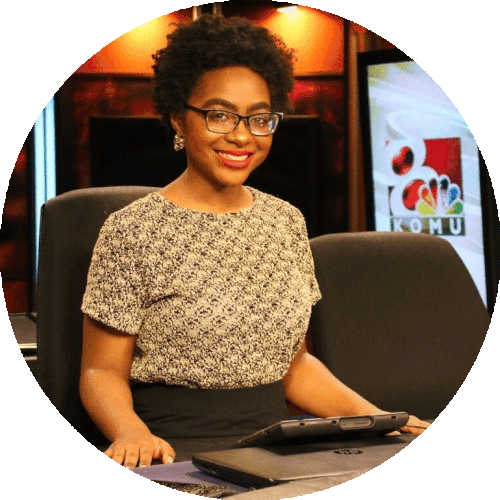Wellness experts share tips for Black Chicagoans coping with grief during the holidays
Aya-Nikole Cook, of Haji Healing Salon, leads a group through yoga practices | Photo by Kymon Kyndred
The holiday season is in full effect. For the past week or so, families have been busting out the Christmas decorations, deciding which of their estranged relatives might get a Christmas gift this year and, if you’re anything like me, playing their favorite holiday hits nonstop. (You’re sure to find James Brown’s “Santa Claus Go Straight to the Ghetto” and Mariah Carey’s “All I Want for Christmas Is You” on my holiday playlist).
But with all this intense focus on family, togetherness and holiday cheer, it’s easy for many Black Chicagoans to feel left out. For many people, celebrating the holidays hasn’t been the same for years. Between losing loved ones, being constantly inundated with Black death on viral social media videos or not having the finances to put on the “perfect” Christmas, it can be too much for some to handle, which brings on depression.
Former Mayor Rahm Emanuel closed six of Chicago’s 12 mental health facilities in 2012, and another one was privatized in 2016, which left only five facilities to serve all of the city’s mental health needs. On a national level, according to the National Alliance on Mental Illness (NAMI), only about 30 percent of African-American adults with mental illnesses receive treatment each year, compared to the national average of about 43 percent. When you add poverty, a lack of quality education, unemployment, de facto segregation, gun violence and state-sanctioned violence to the equation, it’s no surprise that many Black Chicago communities struggle with depression, grief and loneliness.
With 64 percent of people with mental illness reporting that the holidays generally make their conditions worse and Black people being the least likely to receive treatment, alternative wellness centers across Chicago are offering various methods to help those coping with grief during the holidays. We spoke with Aya-Nikole Cook of Haji Healing Salon and Worsham El of Lotus Trauma Care about the best internal and external practices for those experiencing depression and other mental health issues.
The first practice Cook recommends is yoga, whether it’s a formal class that costs money or doing it on your own with a YouTube video for free. As a yoga teacher of 11 years, she says getting into the practice of moving and breathing regularly can be uplifting to those who are struggling.
“The reason why I came to yoga in the first place was because of my anxiety disorder,” Cook said. “I may be someone who lives with anxiety my whole life possibly. But I can tell you that I function much better with the regular yoga practice that is now at the center of my life. And it’s been about 11 years but the anxiety that I had before was pretty debilitating to the point where there were days I couldn’t leave the house, regular panic attacks and yoga really changed that.”
Worsham El also suggests using more physical activities such as yoga to help combat negative emotions.
“For those who are dealing with things like anger, explosive crying spells [or] a lot of energy coming out, things like exercising and yoga, or more of what we call use of gross motor skills, are going to be a better option for you,” she said.
Acupuncture is another tool Cook has used in her personal life to help treat her depression and anxiety. The traditional Chinese medicine practice involves inserting small, thin needles strategically on the body with the intention of stimulating the flow of chi or qi, understood as a person’s life force. Most Western experts understand the practice to help stimulate nerves, muscles and connective tissues as opposed to the balance of one’s flow of energy through meridians, or pathways, as it’s traditionally been understood.
At just $25 an hour, Haji Healing Salon is one of the most affordable places in the city to receive acupuncture (the treatment can usually cost anywhere from $65 to $150 an hour, according to Cook) and one of very few that centers on serving Black indigenous people.
“It’s really wonderful for dealing with all types of mental and neurological fluctuations,” Cook said. “It’s a very relaxing experience. A lot of people I know are afraid of needles, especially a lot of Black people, and the acupuncture although, yes, it is administered using needles, they’re so tiny and they’re completely sterile.”
As someone who grew up Buddhist and has studied many faiths, Cook has had a history of altar building, a creative spiritual practice that she says can help those who are grieving loved ones during the holidays, looking for ways to connect to those that have passed on, or honor their legacy.
“In the last couple [of] years, I’ve developed a very strong practice of altar building. And, you know, I was born and raised in a Buddhist family and so we always had a Buddhist altar in the house. I always loved taking care of the altar, you know, lighting the candles, lighting the incense, offering the flowers and the grains and, you know, dusting the altar, just kind of taking care of it.”
Cook now keeps what she calls an intuitive altar in order to honor her ancestors. On the altar she keeps for her grandmother, she has a photo of her, water as a symbol of life and purity, a white candle for its fire as well as an object representing something from grandmother’s life — chewing tobacco. She says, there’s no wrong way for people to do something similar.
“Depending on whatever your faith is or your spirituality, you know, there are certain protocols that different faiths have and require for altars, right? But if you’re new to it, and you’re open spiritually, and you just want to build something that gives you a connection, I say follow your own inner guidance, and just do what feels right to you,” she said. “Create a little sacred space in your home that’s a refuge and a place of honoring and that’s somewhere that you could, you know, you could sit in that space and pray, knowing that your ancestors are all around you.”
For Worsham El, it’s important that she doesn’t offer any methods to her clients that she hasn’t tried herself. Some of the ones that’s she’s found to be the most successful both in her work and individually are more body-based healing techniques such as grounding, progressive muscle relaxation, and deep breathing because of the central nervous system’s role in triggering stress-responses.
Grounding uses the five senses to immediately reconnect to the here and now, to “ground you in the moment,” which some believe can have a positive effect on the body.
“I always recommend things like grounding,” Worsham El said, “which is when you’re using your five senses to help bring yourself to the present moment because oftentimes, our brains will want to take us to the future or the past. And in that process, we find ourselves getting worked back up as though we are in the future or the past.”
Some examples of grounding include listening to music, smelling a candle, popping a sheet of bubble wrap, taking a bite of a pepper, putting your hands in water and touching a soft blanket. According to Worsham El, using techniques like grounding and others that tap into your body’s inner workings greatly helps address negative emotions. Progressive muscle relaxation is one that she uses with her clients in order to relieve tension
“It’s when you are tensing up your parts of your body or your large muscles. You’ll tense up your face or you’ll tense up your shoulders or your arms or your thighs or your feet. And you’ll do it group by group and as you tense and release them, it’s sending calming signals to your brain.”
Worsham El also says deep breathing can help since, as she says, “when we’re experiencing trauma, overwhelming stress, and anxiety, we start to breathe incorrectly and we’re breathing in our chest as opposed when our diaphragm.” She suggests breathing as though your stomach is being filled with air like a balloon and then breathing out like the balloon is deflating.
For Cook, out of all the techniques you can use to help manage grief, loneliness, stress and mental health issues can be made stronger when used along with a community healing model of thinking. The model is based on the idea that a big part of what makes people sick is an “illusion of isolation.”
“Western culture will tell us that we are all alone and that we all have to pull ourselves up by our bootstraps, and we all have to, you know, make a go of it all on our own and it doesn’t really promote strong community and relationship building,” Cook said. “And so this notion is sort of the opposite of the way that we are as people of color. Indigenous cultures, black people, African cultures have always done things in community and we’ve always healed in community.
“And so it’s really important to me that Haji Healing Salon address the entire person, you know, the physical, the spiritual, the emotional and even the intellectual issues that we show up with that contribute to illness,” she said. “And I find that with the community healing model, it means basically, we heal together.”


